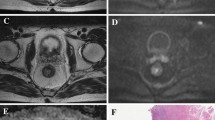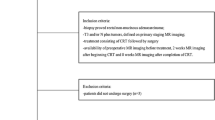Abstract
Purpose
To determine the added value of qualitative and quantitative evaluation of diffusion-weighted magnetic resonance imaging (DWI) in locally advanced rectal cancer (LARC) restaging after neoadjuvant chemo-radiotherapy (CRT).
Materials and Methods
A retrospective study was performed of 21 patients with LARC treated with CRT. All patients were evaluated with 1.5 T conventional magnetic resonance imaging (MRI) and DWI (0–1000 s/mm²) before starting therapy and after neoadjuvant CRT. All included patients underwent surgery after CRT: the histopathological evaluation of surgical specimens represented the reference standard for local staging after neoadjuvant therapy. The qualitative analysis was carried out by two operators in consensus, who reviewed the conventional MR image set [T1-weighted and T2-weighted morphological sequences + dynamic contrast-enhanced sequences (DCE)] and the combined set of conventional and DW images. For the quantitative analysis, the apparent diffusion coefficient (ADC) values were measured at each examination. For each lesion, the mean ADC value (ADCpre and ADCpost) and the ΔADC (ADCpost – ADCpre) were calculated, and values of the three groups of response [complete response (pCR), partial response (pPR), stable disease (pSD)] were compared.
Results
In LARC restaging, conventional MRI showed a sensitivity of 80% and a specificity of 50%, with a total diagnostic capacity of 71.40%, while by adding DWI sensitivity increased to 100%, specificity to 67%, and total diagnostic capacity to 90.40%. ΔADC correlates with treatment response and a cutoff of 1.35 × 10−3 mm²/s predicts the pCR with a sensitivity of 93.3% and a specificity of 83.3%.
Conclusions
Adding DWI to conventional sequences may improve MRI capability to evaluate tumor response to CRT. The quantitative DWI assessment is promising, but larger studies are required.







Similar content being viewed by others
References
Lezoche G, Baldarelli M, Guerrieri M, et al., A prospective randomized study with a 5-year minimum follow-up evaluation of transanal endoscopic microsurgery versus laparoscopic total mesorectal excision after neoadjuvant therapy, Surg Endosc, 2008;22:352-358.
Lezoche E, Baldarelli M, Lezoche G, et al., Randomized clinical trial of endoluminal locoregional resection versus laparoscopic total mesorectal excision for T2 rectal cancer after neoadjuvant therapy, Br J Surg, 2012;99:1211-1218.
Habr-Gama A, Perez MO, Nadalin W, et al., Operative versus nonoperative treatment for stage 0 distal rectal cancer following chemoradiation therapy: long-term results, Ann Surg, 2004;240:711-717.
Marijnen CA, Kapiteijn E, van de Velde CJ, et al., Acute side effects and complications after short-term preoperative radiotherapy combined with total mesorectal excision in primary rectal cancer: report of a multicenter randomized trial, J Clin Oncol, 2002;20:817-825.
Sartori CA, Sartori A, Vigna S, Occhipinti R, Baiocchi GL, Urinary and sexual disorders after laparoscopic TME for rectal cancer in males, J Gastrointest Surg, 2011;15:637-643.
Maas M, Nelemans PJ, Valentini V, et al., Long-term outcome in patients with a pathological complete response after chemoradiation for rectal cancer: a pooled analysis of individual patient data, Lancet Oncol, 2010;11:835-844.
Perez RO, Habr-Gama A, Pereira GV, et al., Role of biopsies in patients with residual rectal cancer following neoadjuvant chemoradiation after downsizing: can they rule out persisting cancer?, Colorectal Dis, 2012;14:714-720.
Hanly AM, Ryan EM, Rogers AC, et al., Multicenter Evaluation of Rectal cancer ReImaging pOst Neoadjuvant (MERRION) Therapy, Ann Surg, 2014;259:723-727.
Huh JW, Park YA, Jung EJ, Lee KY, Sohn SK, Accuracy of endorectal ultrasonography and computed tomography for restaging rectal cancer after preoperative chemoradiation, J Am Coll Surg, 2008;207:7-12.
Curvo-Semedo L, Lambregts DM, Maas M, et al., Diffusion-weighted MRI in rectal cancer: apparent diffusion coefficient as a potential noninvasive marker of tumor aggressiveness, J Magn Reson Imaging, 2012;35:1365-1371.
Kim SH, Lee JM, Hong SH, et al., Locally advanced rectal cancer: added value of diffusion-weighted MR imaging in the evaluation of tumor response to neoadjuvant chemo- and radiation therapy, Radiology, 2009;253:116-125.
Marouf RA, Tadros MY, Ahmed TY, Value of diffusion-weighted MR imaging in assessing response of neoadjuvant chemo and radiation therapy in locally advanced rectal cancer, Egyptian Journal of Radiology and Nuclear Medicine, 2015;46:553-561.
Foti PV, Privitera G, Piana S, et al., Locally advanced rectal cancer: Qualitative and quantitative evaluation of diffusion-weighted MR imaging in the response assessment after neoadjuvant chemo-radiotherapy, Eur J Radiol Open, 2016;3:145-152.
Bayram I, Bakir B, Kartal MGD, et al., The role of MRI with diffusion-weighted imaging in restaging rectal cancers after neoadjuvant chemoradiotherapy, S Afr J Rad, 2016;20(1):a967.
The American Joint Commettee on Cancer, AJCC Cancer Staging Manual 8th edition, 2017.
Szafer A, Zhong J, Anderson AW, Gore JC, Diffusion-weighted imaging in tissues: theoretical models, NMR Biomed, 1995;8:289-96.
Bassaneze T, Gonçalves JE, Faria JF, Palma RT, Waisberg J, Quantitative aspects of diffusion-weighted magnetic resonance imaging in rectal cancer response to neoadjuvant therapy, Radiol Oncol, 2017;51(3):270-276.
Jang KM, Kim SH, Choi D, et al., Pathological correlation with diffusion restriction on diffusion-weighted imaging in patients with pathological complete response after neoadjuvant chemoradiation therapy for locally advanced rectal cancer: preliminary results, Br J Radiol, 2012;85:e566-e572.
Pierredon-Foulongne MA, Nougaret S, Bibeau F, et al., Utility of reassessment after neoadjuvant therapy and difficulties in interpretation, Diagn Interv Imaging, 2014;95:495-503.
Xie H, Sun T, Chen M, et al., Effectiveness of the apparent diffusion coefficient for predicting the response to chemoradiation therapy in locally advanced rectal cancer, Medicine, 2015;94(6):e517.
Song I, Kim SH, Lee SJ, et al., Value of diffusion-weighted imaging in the detection of viable tumour after neoadjuvant chemoradiation therapy in patients with locally advanced rectal cancer: comparison with T2 weighted and PET/CT imaging, Br J Radiol, 2012;85:577-586.
Cai G, Xu Y, Zhu J, et al., Diffusion-weighted magnetic resonance imaging for predicting the response of rectal cancer to neoadjuvant concurrent chemoradiation, World J Gastroenterol, 2013;19(33):5520-5527.
Moffat BA, Chenevert TL, Lawrence TS, et al., Functional diffusion map: a noninvasive MRI biomarker for early stratification of clinical brain tumor response, Proc Natl Acad Sci USA, 2005;102:5524-5529.
Kim SH, Lee JY, Lee JM, Han JK, Choi BI, Apparent diffusion coefficient for evaluating tumour response to neoadjuvant chemoradiation therapy for locally advanced rectal cancer, Eur Radiol, 2011;21:987-995.
Lee EM, Hong YS, Kim KP, et al., Phase II study of preoperative chemoradiation with S-1 plus oxaliplatin in patients with locally advanced rectal cancer, Cancer Sci, 2013;104:111-115.
Curvo-Semedo L, Lambregts DMJ, Maas M, et al., Rectal Cancer: assessment of complete response to preoperative combined radiation therapy with chemotherapy - Conventional MR volumetry versus diffusion-weighted MR imaging, Radiology, 2011;260:734-743.
Dzik-Jurasz A, Domenig C, George M, et al., Diffusion MRI for prediction of response of rectal cancer to chemoradiation, Lancet, 2002;360:307-308.
Koh DM, Collins DJ, Diffusion-weighted MRI in the body: applications and challenges in oncology, Am J Roentgenol, 2007;188:1622-1635.
Harrison L, Blackwell K, Hypoxia and anemia: factors in decreased sensitivity to radiation therapy and chemotherapy?, Oncologist, 2004;9:31-40.
Jung SH, Heo SH, Kim JW, et al., Predicting response to neoadjuvant chemoradiation therapy in locally advanced rectal cancer: diffusion-weighted 3 Tesla MR imaging, J Magn Reson Imaging, 2012;35:110-116.
Petrelli F, Sgroi G, Sarti E, Barni S, Increasing the interval between neoadjuvant chemoradiotherapy and surgery in rectal cancer: a meta-analysis of published studies, Ann Surg, 2016;263:458-464.
Probst CT, Becerra AZ, Aquina CT, et al., Extended intervals after neoadjuvant therapy in locally advanced rectal cancer: the key to improved tumor response and potential organ preservation, J Am Coll Surg, 2015;221(2):430-440.
Sloothaak DA, Geijsen DE, van Leersum NJ, et al., Optimal time interval between neoadjuvant chemoradiotherapy and surgery for rectal cancer, Br J Surg, 2013;100:933-939.
Joye I, Debucquoy A, Deroose C, et al., Quantitative imaging outperforms molecular markers when predicting response to chemoradiotherapy for rectal cancer, Radiother Oncol, 2017;124(1):104-109.
Eisenhauer EA, Therasse P, Bogaerts J, et al., New response evaluation criteria in solid tumours: revised RECIST guideline (version 1.1), Eur J Cancer, 2009;45:228-247.
Xiao J, Tan Y, Li W, et al., Tumor volume reduction rate is superior to RECIST for predicting the pathological response of rectal cancer treated with neoadjuvant chemoradiation: results from a prospective study, Oncol Lett, 2015;9(6):2680-2686.
Kim YC, Lim JS, Keum KC, et al., Comparison of diffusion-weighted MRI and MR volumetry in the evaluation of early treatment outcomes after preoperative chemoradiotherapy for locally advanced rectal cancer, J Magn Reson Imaging, 2011; 34(3):570-576.
Ha HI, Kim AY, Yu CS, Park SH, Ha HK, Locally advanced rectal cancer: diffusion-weighted MR tumour volumetry and the apparent diffusion coefficient for evaluating complete remission after preoperative chemoradiation therapy, Eur Radiol, 2013;23(12):3345-3353.
Nougaret S, Vargas HA, Lakhman Y, et al., Intravoxel Incoherent Motion histogram metrics for assessment of response after combined chemotherapy and radiation therapy in rectal cancer: initial experience and comparison between single-section and volumetric analyses, Radiology, 2016;280(2):446-454.
Kim SH, Lee JM, Gupta SN, Han JK, Choi BI, Dynamic contrast enhancement MRI to evaluate the therapaeutic response to neoadjuvant chemoradiation therapy in locally advanced rectal cancer, J Magn Reson Imaging, 2014;40(3):730-737.
Intven M, Monninkhof EM, Reerink O, Philippens ME, Combined T2w volumetry, DW-MRI and DCE-MRI for response assessment after neo-adjuvant chemoradiation in locally advanced rectal cancer, Acta Oncol, 2015;27:1-8.
Nie K, Shi L, Chen Q, et al., Rectal cancer: assessment of neoadjuvant chemo-radiation outcome based on radiomics of multi-parametric MRI, Clin Cancer Res, 2016;22(21):5256-5264.
Lambregts DMJ, Maas M, Riedl RG, et al., Value of ADC measurement for nodal staging after chemoradiation in locally advanced rectal cancer - a per lesion validation study, Eur Radiol, 2010;21:265-273.
van Heeswijk MM, Lambregts DMJ, Palm WM, et al., DWI for assessment of rectal cancer nodes after chemoradiotherapy: is the absence of nodes at DWI proof of a negative nodal status?, Am J Roentgenol, 2017;208(3):w79-w84.
Lahaye MJ, Engelen SM, Kessels AG, et al., USPIO-enhanced MR imaging for nodal staging in patients with primary rectal cancer: predictive criteria, Radiology, 2008;246:804-811.
Heijnen LA, Lambregts DMJ, Martens MH, et al., Performance of gadofosveset-enhanced MRI for staging rectal cancer nodes: can the initial promising results be reproduced?, Eur Radiol, 2014;24:371-379.
Blazic IM, Lilic GB, Gajic MM, Quantitative assessment of rectal cancer response to neoadjuvant combined chemotherapy and radiation therapy: comparison of three methods of positioning region of interest for ADC measurements at diffusion-weighted MR imaging, Radiology, 2017;282(2):418-428.
Author information
Authors and Affiliations
Corresponding author
Additional information
Publisher's Note
Springer Nature remains neutral with regard to jurisdictional claims in published maps and institutional affiliations.
Rights and permissions
About this article
Cite this article
Napoletano, M., Mazzucca, D., Prosperi, E. et al. Locally advanced rectal cancer: qualitative and quantitative evaluation of diffusion-weighted magnetic resonance imaging in restaging after neoadjuvant chemo-radiotherapy. Abdom Radiol 44, 3664–3673 (2019). https://doi.org/10.1007/s00261-019-02012-4
Published:
Issue Date:
DOI: https://doi.org/10.1007/s00261-019-02012-4




